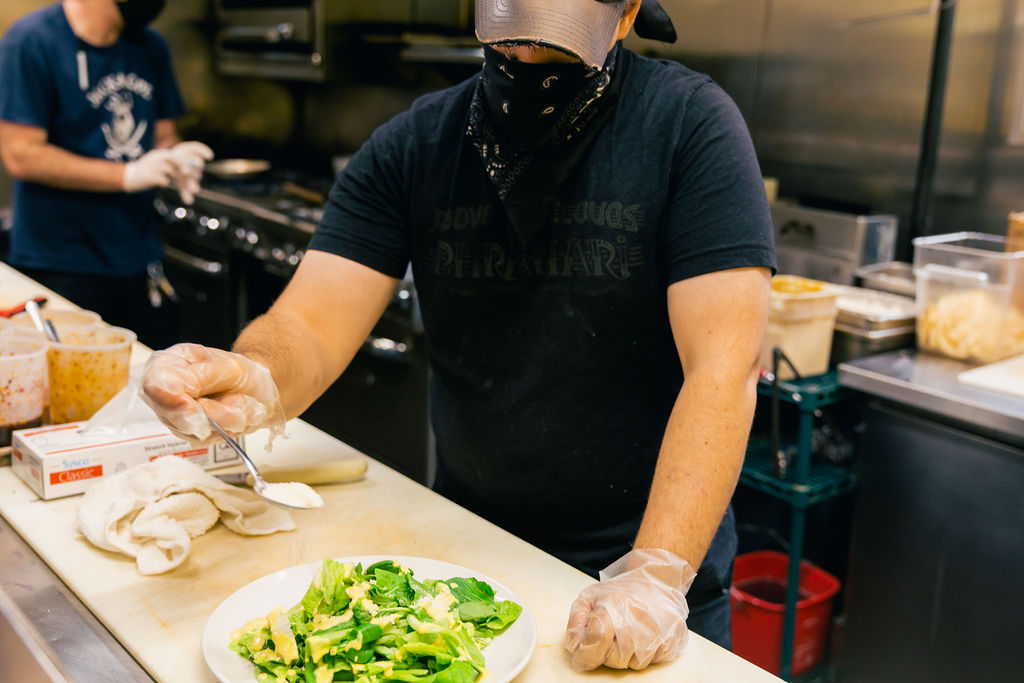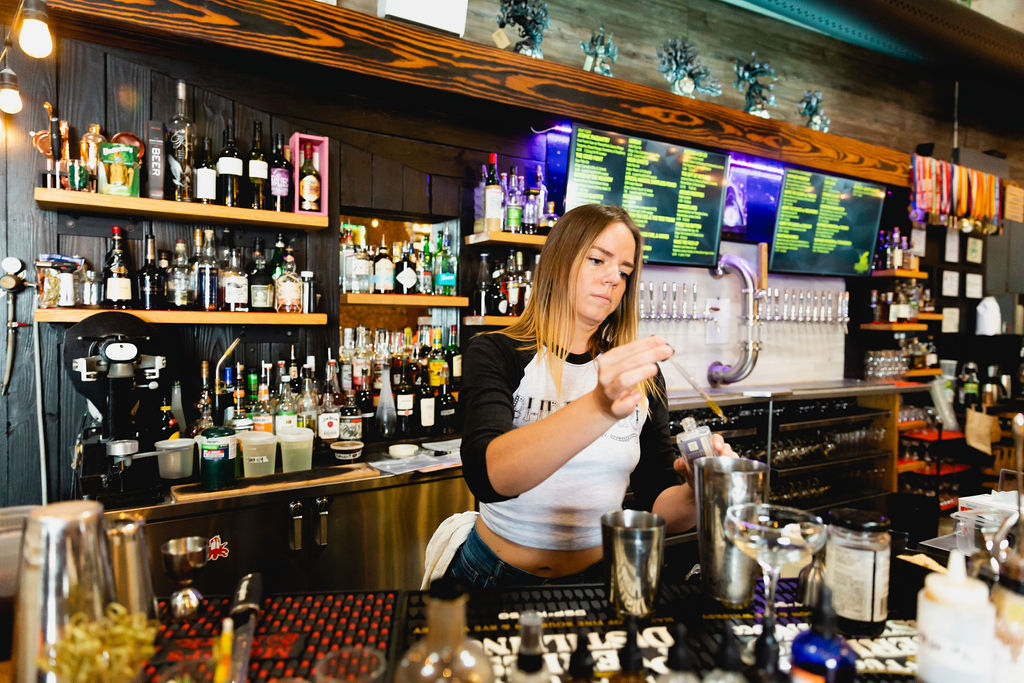All You Can Say Buffet: Restaurant & Bar Lingo You Should Know
We’re firing off the kitchen lingo in this post! Get ready to add these to your vocab.

Whether you’re a seasoned restaurant veteran, a guest who loves eavesdropping at the bar, or a newbie to it all, there’s likely some lingo out there that’s not yet part of your vocabulary. Below, we break it all down by jargon you’re bound to hear in the kitchen, at the bar, or tableside in the front of house (FOH).
Where Dreams Meals Are Made: Kitchen Lingo
Restaurant kitchens ignite all senses—drool-inducing smells, heat and sizzles from the stove tops, and a view of cooks in perfect synchronization. These are some terms you can expect to hear:
86: The fact that 86 rhymes with “nix” is no coincidence. When used in a restaurant setting, 86 announces something is all out, whether it be an ingredient or a menu item entirely. The origin of 86 is said to be from 1930s soda-counter slang.
All day: This is another word for total. When tickets come in from the FOH, the caller of the kitchen may say something like “We need 5 nachos, all day.” That call covers all the nacho orders of all the tickets that are in.
Behind/Corner: Both of these terms are used for bustling staff members in any area of a restaurant and bar. They’ll shout “behind” if they’re running behind a team member, or “corner” if they’re quickly making a turn, so as to avoid any spills or collisions.
Dead plate: A dead plate is about as sad as it sounds. It deems food that can’t be served, whether it’s because it’s cold, cooked incorrectly, or otherwise off.
Expo: We’ve now got a term for that kitchen caller! Stemming from the word expeditor, a kitchen’s expo not only reads out orders that come in, but also adds garnish or other finishing touches on plates before they’re delivered to guests.
Fire: To fire means to start cooking something. A chef fires desserts when a table finishes up their entrees, for example. (Or, if you’re in a family-friendly restaurant, they fire when the baby starts fussing!)
KDS: KDS stands for kitchen display system, and it’s technology that works with your restaurant POS system to display all in-progress tickets for the back of house (BOH) team. The best POS systems typically integrate with KDS software to ultimately streamline kitchen operations and make food service faster.
Mise en place: Pronounced “meez-on-plahs”, this French culinary phrase directly translates to “everything in its place”. It’s used to describe a cook’s station with all of their prepped ingredients ready to go.
SOS: In the kitchen, SOS has nothing to do with a sinking vessel—unless that vessel is a french fry sinking in a pool of aioli! SOS on an order ticket means sauce on the side, and it’s an easy call-out to make on POS systems with dynamic tab functionalities.
Stretch: If a kitchen is running low on something, the BOH team will stretch it in order to meet the remaining demand for the night.
Where Every Hour Is Happy: Bar Lingo
While not nearly as intimidating as ordering at a Starbucks drive-thru, perfecting your drink order at the bar takes practice. Here are some terms that bartenders and guests alike benefit from knowing:
Back: Known as a chaser by your sorority alumni friends, a back is a drink that follows a shot of liquor. For example, a guest may order a shot of vodka with a pickle back, and that means they’d like a pickle juice shot to chase the vodka with.
Broken: This can obviously be used to describe a physically broken bottle, but it also calls out a bottle that was emptied. Broken is like a bar’s “86”!
Burnt: When a bartender adds scotch to a martini, it’s considered burnt.
Dirty: Another clarifying term for martini enthusiasts: A dirty martini includes olive juice.
Float: A Bloody Maria with a tequila float is our Sunday morning alarm clock. When a liquor or syrup is slowly poured on top of a drink to create layers, it’s called a float.
Frost: There’s few better ways to drink a pint. Some bars dip glasses in water, drain them, and then place them in freezers to create frosted glasses for beer orders.
Highball: If a guest asks for a highball, they want liquor mixed with soda water served in a tall, thin glass.
Layering: There’s a lot of dexterity that goes into bartending, and layering is definitely a flex of that artistry. Like floats, layering is when the heaviest alcohol is poured first, and the lighter alcohol is floated on top using an inverted spoon or a careful pour technique.
Muddle: To muddle is to mash ingredients—such as fruit, herbs, and spices—at the bottom of a glass. A muddler tool is used, and this technique adds dimension and flavor to cocktails.
Neat: Nothing-else might as well be a synonym for neat in a bar’s case. Requesting a drink neat means straight from the bottle with zero additions—not even ice.
Point: The point of a bar refers to the part that’s closest to the entrance, and therefore sees the highest amount of guest traffic. Your especially efficient bartender usually mans the point.
Pony: This is a mini shot: Whereas standard shots are 1.5 ounces, a pony is 1 ounce. Yeehaw!
Straight up: A drink is straight up if it’s shaken or stirred, strained, and then served in a stemmed glass without ice.
Toddy: Warm up that sweet tooth with a toddy! It’s a cocktail with hot water, and often served with spices like cinnamon, black pepper, or nutmeg.
Twist: A curled citrus skin garnish added for flavor or just decoration is a twist.
Wet: Think of it this way: A strong drink is the opposite of a wet one. Wet indicates a cocktail that has more mixer and less alcohol than the standard recipe.

Where The Guest Magic Happens: Front Of House Lingo
The food is warm and drinks are cold. Now it’s time to get guests in on the action! Here are some common terms used by front of house staff:
Comp: This is short for complimentary. A comp is used to remove something from a bill, such as a nicety from the server to comp the birthday boy’s dessert.
Cut: It’s no secret that minimizing labor costs is at the top of every business owner’s mind. This focus on staffing just enough to meet guest demand may cause cuts in the front of house, or staff members’ shifts ending early. It’s also called a cut if you remind staff their scheduled shift has ended.
Floor: This doesn’t refer to the actual floor, but instead the FOH area entirely. The dining room, kitchen, and bar are all included in the floor.
Grat: Short for gratuity, this typically refers to a tip that was automatically applied due to party size or newfound restaurant and bar policies.
Heard: This is used between staff members to confirm an understanding. It’s said often in all areas of a restaurant and bar’s floor.
In the weeds: If a staff member is in the weeds, it means they’re overwhelmed with the tasks at hand.
Push: Servers push certain dishes when a restaurant and bar is purposefully trying to sell that item. It could be that there’s too much inventory, or that the ingredients are simply losing their freshness and need to be used.
Sommelier: A fancy term for a fancy position: A sommelier is the certified wine expert on staff who manages the wine program and lists, and helps guests choose the best wines for their meal.
Turn and burn: When servers turn and burn, they’re working to quickly get guests out of tables and prepare for the next party. It’s a tactic typically reserved for busy Saturdays or when a restaurant attempts to maximize sales revenue and tips.
Want more? Scratch that vocab itch by checking out Beer, Taproom, & Brewery POS Lingo You Should Know.
